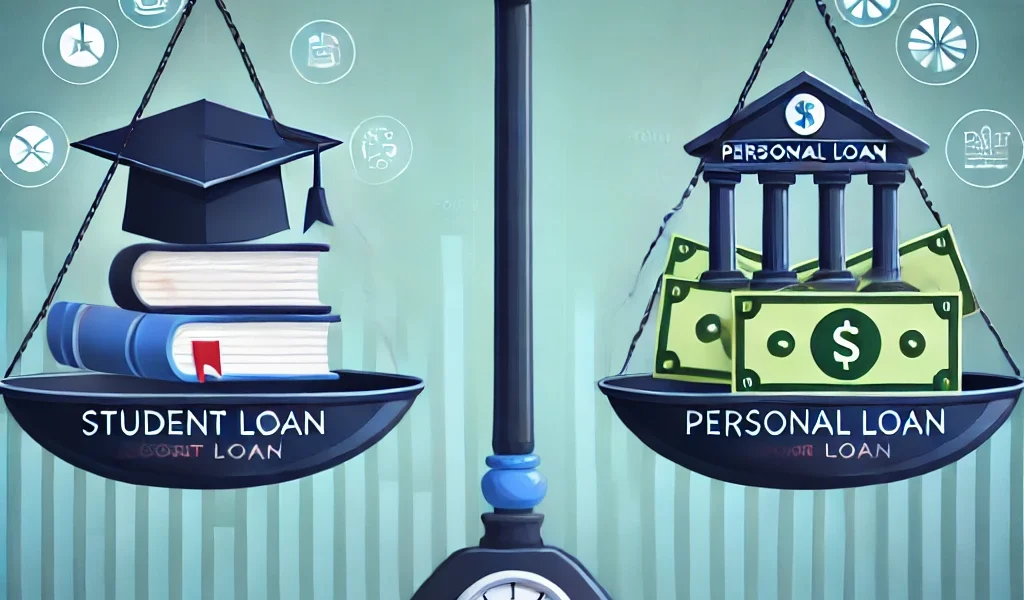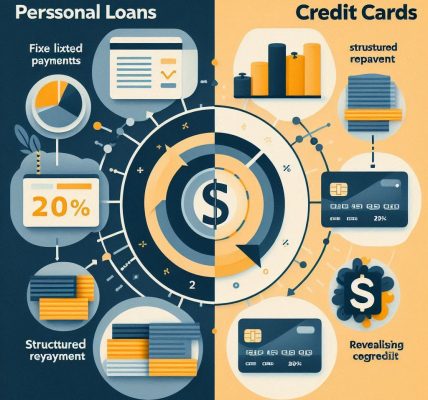Introduction
When it comes to financing education, two common loan options come into play: student loans and personal loans. While both can help cover tuition and related expenses, they serve different purposes and come with distinct terms and conditions. Understanding the differences between these two loan types is crucial in making an informed financial decision.
This comprehensive guide will explore the pros and cons of student loans and personal loans, compare their features, and help you determine which option is best suited to your needs.
Understanding Student Loans
Student loans are specifically designed to finance education-related expenses, including tuition, books, supplies, and sometimes living costs. These loans are offered by the government (federal student loans) or private lenders.
Types of Student Loans
- Federal Student Loans:
- Offered by the U.S. Department of Education.
- Lower interest rates compared to private loans.
- Flexible repayment plans and forgiveness options.
- Subsidized and unsubsidized loan options available.
- Private Student Loans:
- Provided by banks, credit unions, and private lenders.
- Interest rates vary based on credit score and lender policies.
- Fewer repayment options compared to federal loans.
Pros of Student Loans
✅ Lower Interest Rates: Federal student loans typically offer lower fixed interest rates than personal loans.
✅ Deferred Payments: Many student loans allow you to defer payments while in school and for a grace period after graduation.
✅ Income-Driven Repayment Plans: Federal loans offer repayment plans based on income, making monthly payments more manageable.
✅ Loan Forgiveness Programs: Certain federal loans may be eligible for forgiveness after working in public service for a specific number of years.
Cons of Student Loans
❌ Limited Usage: Funds can only be used for education-related expenses.
❌ Long-Term Debt: Student loans can take years or even decades to pay off.
❌ Limited Borrowing Amounts: Federal student loans have borrowing limits, which may not cover all expenses.
Understanding Personal Loans
Personal loans are unsecured loans that can be used for almost any purpose, including education. They are provided by banks, credit unions, and online lenders.
Features of Personal Loans
- Fixed or variable interest rates.
- Typically requires a good credit score for approval.
- No restrictions on fund usage.
- Shorter repayment terms compared to student loans.
Pros of Personal Loans
✅ Flexible Usage: Personal loans can be used for tuition, living expenses, or other financial needs.
✅ No Need for FAFSA: Unlike federal student loans, personal loans do not require completing the Free Application for Federal Student Aid (FAFSA).
✅ Quick Approval Process: Many lenders offer fast approval and funding within a few days.
✅ Shorter Repayment Terms: You can pay off personal loans more quickly, avoiding long-term debt.
Cons of Personal Loans
❌ Higher Interest Rates: Personal loans often have higher interest rates than federal student loans, especially for borrowers with poor credit.
❌ Strict Eligibility Requirements: A strong credit score and stable income are usually required for approval.
❌ Immediate Repayment Required: Unlike student loans, personal loans require repayment as soon as funds are disbursed.
Student Loans vs. Personal Loans: A Side-by-Side Comparison
| Feature | Student Loans (Federal) | Private Student Loans | Personal Loans |
|---|---|---|---|
| Interest Rates | Lower (fixed) | Varies (fixed/variable) | Higher (depends on credit) |
| Usage Restrictions | Education-related only | Education-related only | No restrictions |
| Repayment Start | After graduation (grace period) | Varies by lender | Immediately after disbursement |
| Repayment Terms | 10-30 years | 5-20 years | 1-7 years |
| Forgiveness Options | Yes (for federal loans) | No | No |
| Credit Score Requirement | Not required for most | Required | Required |
When to Choose a Student Loan
- You are enrolled in a degree program and need financial aid.
- You want lower interest rates and flexible repayment options.
- You need a loan that offers deferment and potential forgiveness programs.
- You have maxed out federal loan options and need additional funding (private student loans).
When to Choose a Personal Loan
- You have exhausted student loan options and still need funding.
- You need a loan for both education and non-education expenses.
- You have a good credit score and can qualify for competitive interest rates.
- You can afford to make payments immediately after receiving the loan.
Tips for Borrowing Responsibly
Regardless of the loan type, it’s crucial to borrow responsibly to avoid long-term financial stress. Here are some tips:
- Only Borrow What You Need: Avoid borrowing more than necessary to keep future debt manageable.
- Compare Interest Rates: Always shop around for the best rates and terms.
- Understand Repayment Terms: Know when and how you need to start repaying your loan.
- Check for Fees: Some personal loans have origination fees or prepayment penalties.
- Build a Budget: Plan your finances so you can make timely payments without financial strain.
- Monitor Your Credit: Regularly check your credit score to ensure responsible loan management.
Conclusion
Choosing between student loans and personal loans depends on your unique financial situation and educational needs. If you qualify, federal student loans are generally the better option due to lower interest rates, flexible repayment terms, and potential forgiveness programs. However, if federal loans don’t cover all expenses, private student loans or personal loans may be necessary.
Ultimately, the best choice is the one that aligns with your financial goals and ability to repay the loan responsibly.
Legal Disclaimer: This article is for informational purposes only and does not constitute financial or legal advice. Always consult a financial expert before making borrowing decisions.




